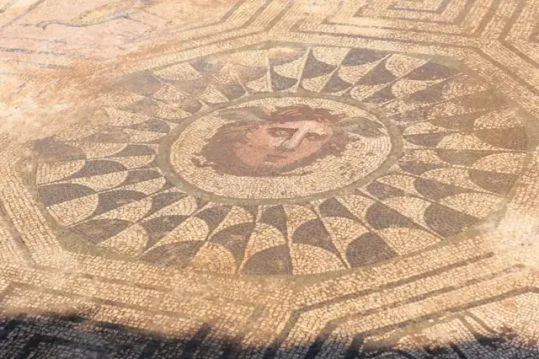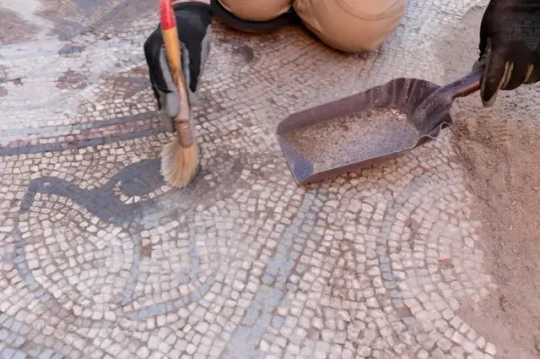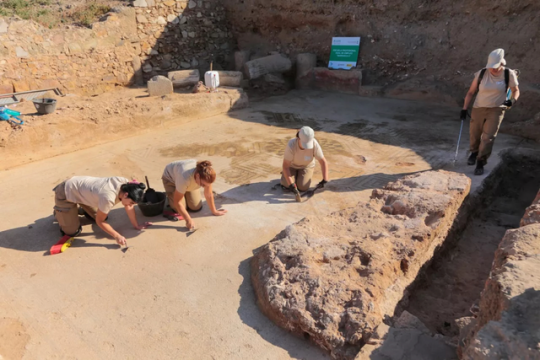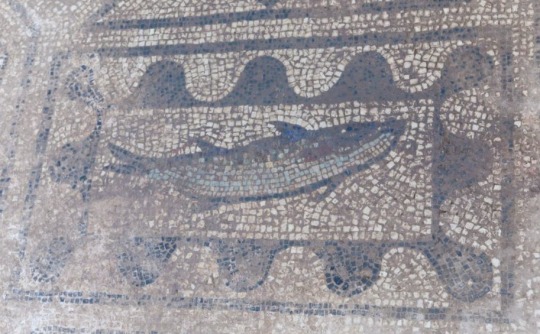#Huerta de Otero archaeological site
Text

Archaeologists Unearth Ancient Mosaic of Winged Medusa in Spain
The stunningly preserved Ancient Roman mosaic floor was found at the Huerta de Otero site in the city of Mérida.
In both ancient and modern interpretations, Medusa is often known as a monster — a Gorgon with tresses of serpents whose stare turned men to stone. This version typically appears in children’s movies and fantasy thrillers, but her image hasn’t always been so awe-inspiring. In late June, archaeologists in Western Spain uncovered an Ancient Roman mosaic floor that depicts Medusa with tiny wings and flowing locks of hair, thought to have been used as a protective symbol.

The mosaic was found in the city of Mérida’s Huerta de Otero archaeological site. Ancient Romans established a colony there in 25 BCE named Augusta Emerita. Traces of its former inhabitants — including an amphitheater and a bridge — can be found throughout the modern-day city. “[The site] is of an exceptional nature due to the level of conservation of the ruins and, above all, the ornamental elements that decorate the well-preserved house: not only the mosaic of the Medusa but also paintings and sculptural motifs,” said archaeologist Félix Palma in a statement.
The Huerta de Otero location was excavated in 1976 but lay untouched for decades. Research picked back up in 2019, when the city employed professional archaeologists and students from its Barraeca II Professional School to explore the ruins. Since then, the team has uncovered an Ancient Roman defensive wall, a road, and the home of a wealthy family.
The Medusa mosaic adorned the floor of this home. Depictions of fish, peacocks, and carefully tessellated patterns surround the artwork’s central figure: a human-like Medusa, her gaze turned to one side.


Although this image diverges from some contemporary renditions of the mythological figure, the mosaic’s winged version was common in Ancient portrayals of Medusa. While early Greek depictions of the mortal-turned-monster, cruelly punished for being raped by the god Poseidon, show her as grotesque, Medusa’s image softened by the time of the Ancient Romans. Beginning in the Classical Greek period, her face acquired more human attributes. It started to be rendered with symmetry and youthful beauty in the following centuries.
Other Ancient Roman mosaics featuring the head of Medusa have been discovered throughout Spain. Medusa again comprises the focal point of an Ancient Roman mosaic in a 115–150 CE work found in Rome, where she can be seen sporting human curls and a snake around her neck. A 1st-to-2nd-century ornament from a chariot pole shows a young woman with curly locks (although a couple of snakes still peer through her tangle of hair).
In Ancient Greek mythology, Perseus killed Medusa to avoid being turned to stone. Medusa, in her early terrifying form, was used as a protective symbol — “an image of evil to repel evil,” Madeleine Glennon writes in a 2017 essay for the Metropolitan Museum of Art. The goddess Athena famously included a representation of Medusa’s severed head on her protective cloak or aegis. In Ancient Rome, her beautified image was still employed as a protective symbol, although the depiction shifted into a form more similar to a woman than a monster.
By Elaine Velie.


#Archaeologists Unearth Ancient Mosaic of Winged Medusa in Spain#mosaic#roman mosaic#Mérida Spain#Huerta de Otero archaeological site#ancient artifacts#archeology#archeolgst#history#history news#ancient history#ancient culture#ancient civilizations#roman history#roman empire#roman art
600 notes
·
View notes
Text
'Exceptional' winged Medusa discovered in Roman-era mosaic in Spain

The mosaic, found at the Huerta de Otero archaeological site in western Spain, depicts Medusa at the center of a patterned octagon, meant to represent the aegis of Athena, a shield or skin that held Medusa's severed head after the Greek hero Perseus beheaded the gorgon. In the mosaic, Medusa is surrounded by masks, geometric patterns and wildlife, including fish and four colorful peacocks that represent the four seasons, according to a translated statement.
The thick-browed depiction of Medusa would have served as an apotropaic, or means to repel evil, José Vargas, an archeology monitor for the Barraeca II Professional School that carried out the dig, said in the statement.
The mosaic has four colorful peacocks that represent the four seasons. (Image credit: Mérida City Hall)
Most people think Medusa had snakes for hair and turned people who looked directly at her into stone. In early Greece, the mortal gorgon was illustrated as hideous and monstrous — sometimes with a beard and even tusks and pointy teeth. But in Roman times around A.D. 100, her snaky hair was often detailed as wild locks and she took on the features of Alexander the Great, such as having wind-blown hair and a turned head, according to the Getty Center in Los Angeles.
Related: Silver medal featuring winged Medusa discovered at Roman fort near Hadrian's Wall
The Medusa section of the mosaic is surrounded by depictions of masks, geometric patterns and wildlife. (Image credit: Mérida City Hall)
In the newfound mosaic, Medusa has a round face, bulging eyes, unkempt hair, a slightly turned face and white wings coming out of her forehead, an indication that she could fly, much like the Roman deity Mercury. The fact that the mosaic is multicolored, instead of just black and white, indicates that it was crafted in the second century A.D., according to The History Blog.
RELATED STORIES
—Mysterious mosaics depicting Medusa uncovered at 2nd-century Roman villa
—Vast subterranean aqueduct in Naples once 'served elite Roman villas'
—Heavy rains expose ancient phallus and 'imposing' face carvings at Roman fort in Spain
The 323-square-foot (30 square meters) mosaic was found by students. Archaeologists first excavated the site in 1976, finding the remains of a Roman domus, or house. But little work was done at the site until students renewed excavation there in 2019, leading to the discovery of the mosaic this summer, according to the statement. It's likely that the mosaic decorated one of the domus's main rooms, such as the triclinium, or dining room, according to The History Blog.
This site "is of an exceptional nature due to the level of conservation of the remains and, above all, due to the ornamental apparatus that decorates the well-preserved house: not only the mosaic of the medusa but also paintings and sculptural motifs," Félix Palma, director of the Monumental City Consortium, said in the statement.
Read the full article
0 notes